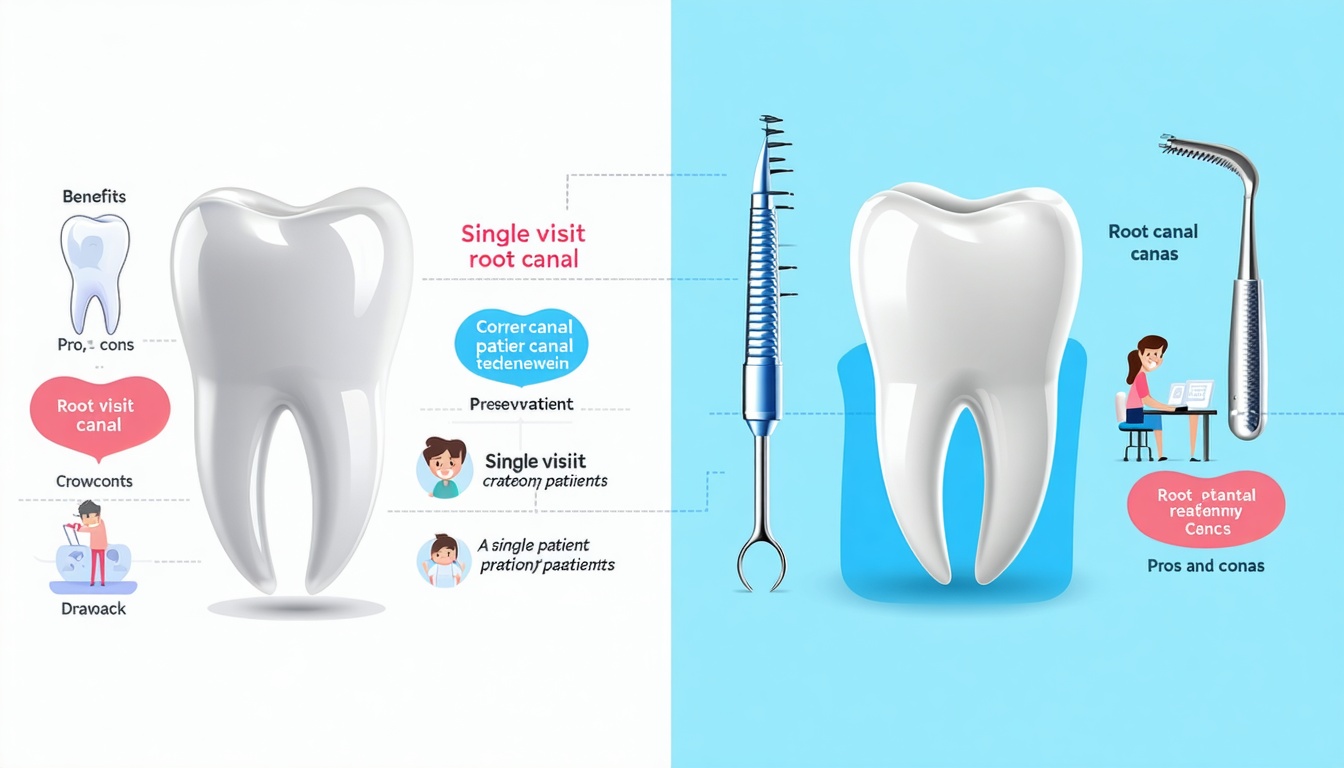Understanding Root Canal Treatment
Root canal treatment is often a necessary procedure for preserving your natural teeth when faced with serious dental issues. Here, you’ll gain insight into the purpose and process of a root canal, including how a single-visit approach could be beneficial for you.
Purpose of Root Canal
The primary goal of a root canal is to remove infected or damaged pulp from within a tooth to alleviate pain and prevent further complications. Single-visit root canals, ideal for individuals with busy schedules, enable you to receive immediate relief from discomfort in a single appointment. This type of treatment has shown to be viable, with studies indicating that approximately fifty minutes are needed to complete the procedure effectively. In one evaluation of defense dental setups, 90% of cases reviewed were asymptomatic six months after treatment (PMC).
By completing the root canal in one visit, you benefit from reduced risk of infection through prompt restoration and tooth protection. This proactive approach promotes better healing and faster recovery than traditional methods that involve multiple appointments, allowing for a comprehensive attention to your dental needs without extended wait times.
Process of Root Canal
The process of a root canal typically involves several key steps, whether conducted in a single visit or across multiple sessions. In a one-appointment procedure, the process is streamlined, which reduces the potential for complications associated with temporary seal leakage. During this treatment, technological advancements in digital imaging and advanced rotary instruments are utilized to ensure precision and effectiveness.
- Diagnosis: Your dentist evaluates the affected tooth using X-rays and clinical examination.
- Anesthesia: Local anesthesia is administered to ensure your comfort during the procedure.
- Pulp Removal: The infected pulp tissue is carefully removed from the tooth.
- Cleaning and Shaping: The empty root canals are cleaned and shaped to prepare for filling.
- Filling: The canals are filled with a biocompatible material to prevent future infection.
- Restoration: A final restoration, often in the form of a crown, is placed to restore the tooth’s function and appearance.
Completing this entire process in one session not only enhances efficiency but also decreases the risk of flare-ups during the healing period (Dentistry For Midtown).
By understanding the purpose and process of root canal treatment, you can make an informed choice about the best approach for your dental health. For more information on what you can expect regarding root canals, see our articles on what is root canal treatment and root canal procedure steps.
Single-Visit vs. Multiple-Visit Root Canals
Pros and Cons Analysis
When considering root canal options, it’s essential to weigh the pros and cons of single-visit and multiple-visit treatments. Each approach has its strengths and potential drawbacks. Here’s a comparison to help you make an informed decision:
| Feature | Single-Visit Root Canal | Multiple-Visit Root Canal |
|---|---|---|
| Duration | Completed in a single appointment | May require several appointments over weeks |
| Convenience | Ideal for busy schedules seeking immediate relief | Allows for a more comprehensive approach |
| Postoperative Pain | Higher likelihood of pain within the first week | Generally lower pain rates post-treatment |
| Treatment Thoroughness | May not allow for as thorough an evaluation | Comprehensive assessment over several visits |
| Asymptomatic Outcome | 90% asymptomatic six months post-procedure | Similar long-term success rates |
Single-visit root canals allow for immediate relief from pain, making them suitable for patients with demanding schedules or urgent treatment needs. However, studies indicate that single-visit procedures may result in higher postoperative pain levels within the first week compared to their multiple-visit counterparts (PubMed Central). In contrast, multiple-visit treatments provide a more gradual approach, potentially enabling better diagnosis and thorough treatment of any underlying issues.
Factors Influencing Choice
Your choice between single-visit and multiple-visit root canals may depend on several factors, including:
- Scheduling Needs: If you have a busy life, a single-visit procedure might be more convenient.
- Pain Tolerance: If you’re concerned about post-treatment discomfort, multiple visits might offer a more gradual experience.
- Severity of Infection: Complex cases may benefit from a more extensive assessment typically associated with multiple visits.
- Dentist Recommendations: Your dental professional’s opinion on what procedure suits your specific case will play a crucial role.
- Personal Preference: Comfort levels with the treatment process and immediate goals for pain relief can guide your choice.
Understanding these factors will help you determine the best option for your needs. If you’re experiencing symptoms that indicate a root canal may be necessary, learn more about signs you need a root canal. For an overview of the procedure, read about what is root canal treatment.
Effectiveness of Single-Visit Root Canals
Success Rates Comparison
When considering the single visit root canal pros and cons, it’s important to examine the success rates of this treatment compared to traditional multiple-visit procedures. Research has shown that the success rates of single-visit root canals are comparable to those of multiple-visit root canals, with the rates standing at 88.9% and 87.4%, respectively. This indicates that there is negligible difference in effectiveness between the two methods (BMC Oral Health).
| Treatment Type | Success Rate (%) |
|---|---|
| Single-Visit | 88.9 |
| Multiple-Visit | 87.4 |
While outcomes are similar, single-visit treatment offers notable advantages such as less chair-time and fewer overall procedures, which can be particularly beneficial for patients on tight schedules.
Healing and Recovery
Healing and recovery times are another critical aspect of evaluating the effectiveness of single-visit root canals. Studies indicate that post-operative pain and healing rates are similar whether the treatment is performed in one visit or multiple visits. However, specific benefits arise from single-visit procedures due to immediate restoration. By completing the root canal in one session, the risk of infection is decreased as the tooth is promptly restored and protected, aiding in faster recovery. The chart below summarizes healing and recovery factors:
| Treatment Type | Typical Recovery Time | Post-Operative Pain |
|---|---|---|
| Single-Visit | 1-2 weeks | Similar to multiple-visit |
| Multiple-Visit | 1-2 weeks | Similar to single-visit |
Ultimately, single-visit root canals cater to those seeking efficiency and convenience in dental care without sacrificing the quality of treatment. If you’re considering whether a root canal is right for you, our resources on what is root canal treatment and signs you need a root canal can provide valuable insight. Additionally, explore our section on root canal recovery time to prepare for your healing process.
Factors Influencing Treatment Outcomes
When considering single visit root canal pros and cons, it’s important to acknowledge the various factors that can impact the success of the procedure. Key elements include technological advancements and the materials and techniques used during treatment.
Technological Advancements
Recent advancements in dental technology have significantly contributed to the effectiveness of root canal procedures, especially in single-visit treatments. Innovations such as digital imaging have allowed for precise diagnostics, enhancing the ability to visualize the root canal system. This enables dentists to identify issues more effectively before beginning treatment.
Moreover, advanced rotary instruments like nickel titanium (NiTi) files have been proven to improve outcomes. These instruments are five times more likely to achieve successful results compared to traditional stainless steel files. They maintain the original canal shape and predictably enlarge canals while effectively removing bacterial cells. The incorporation of improved sealing materials further enhances the isolation of the canal environment, reducing the risk of complications.
| Technological Advance | Impact |
|---|---|
| Digital Imaging | Enhanced diagnostics |
| Nickel Titanium Rotary Instruments | Improved treatment success |
| Advanced Sealing Materials | Reduced complications |
Materials and Techniques
The choice of materials utilized in root canal therapy also plays a crucial role in treatment outcomes. For instance, the use of calcium hydroxide in multiple-visit procedures offers antimicrobial benefits that contribute to better healing rates. However, studies show that while additional dressing with calcium hydroxide slightly increases healing rates, the overall success rates between single and multiple-visit root canal treatments are comparable (NCBI).
Both single and multiple visits facilitate adequate disinfection of the root canal system; however, single-visit procedures eliminate the risk of inter-appointment leakage through temporary restorations, which can be a concern in multiple visits. This leads to quicker treatment times and often reduced costs for patients. It’s essential to discuss these options with your dentist to determine the most suitable approach for your situation.
| Material/Technique | Advantage |
|---|---|
| Calcium Hydroxide | Antimicrobial properties (in multiple visits) |
| Single-Visit Procedures | Reduced risk of leakage, faster treatment |
The selection of the right technology and materials can significantly influence your root canal treatment’s effectiveness. Understanding these factors, alongside your own dental needs, will help you make an informed decision about your care. For more information on what to expect during the procedure, visit our article on what is root canal treatment.
Patient Experience and Considerations
Pain Management
When considering a root canal, understanding pain management options is essential. Pain levels can vary significantly depending on whether you opt for a single-visit or multiple-visit root canal. Studies indicate that postoperative pain or complications are common after root canal procedures, lasting from one day to several weeks and sometimes including symptoms such as swelling, tenderness, and increased mobility.
Interestingly, some research suggests that patients may experience more pain after a single-visit treatment compared to a multiple-visit treatment, although many dental practitioners generally believe that postoperative discomfort tends to be higher with single-visit procedures. The following table summarizes postoperative pain reports from various studies:
| Study Type | Pain Rate | Notable Findings |
|---|---|---|
| Single-Visit Group | 3% – 50% | Two patients reported pain |
| Multiple-Visit Group | 0% | No pain reported in patients |
A significant finding was that the risk ratio for higher post-treatment pain within the first week for single-visit groups was noted as RR 2.16 for vital teeth (Source). Managing pain effectively can enhance your experience, so discussing pain management techniques and options with your dentist before the procedure is vital.
Recovery Process
Your recovery after a root canal treatment is as critical as the procedure itself. The recovery time may vary based on whether you underwent a single-visit or multiple-visit treatment. Reports show that additional dressing with calcium hydroxide in multiple-visit techniques can improve healing rates slightly due to its antimicrobial properties (NCBI).
During recovery, you’ll likely experience some discomfort, which can be managed with over-the-counter pain relief medications. It’s essential to follow your dentist’s specific post-operative instructions to ensure effective healing. Below is an overview of typical recovery timelines for both treatment types:
| Treatment Type | Typical Recovery Time | Recommendations |
|---|---|---|
| Single-Visit | 1 – 2 weeks | Follow aftercare instructions; monitor for pain |
| Multiple-Visit | 1 – 3 weeks | Additional care with calcium hydroxide; follow-up visits |
Postoperative care is crucial, so be sure to prioritize follow-up visits and adhere to a proper root canal home care aftercare routine. This approach will enhance your comfort and expedite recovery, allowing you to return to normal activities more quickly.
Consultation and Decision Making
Dentist Recommendations
When considering a single visit root canal, it is essential to consult with your dentist. They will evaluate your specific dental condition and symptoms to recommend the most appropriate treatment option. Single-visit root canals can provide significant advantages, especially for straightforward cases. However, if your condition is complex, multiple visits might be necessary to ensure thorough treatment (Dentistry For Midtown).
Your dentist will take into account factors such as:
- The extent of tooth damage
- The health of the pulp (vital or non-vital)
- Any pre-existing dental infections
- Your overall oral health
One key benefit of a single visit root canal is the time-saving aspect, as these procedures can significantly reduce the risk of flare-ups caused by temporary seals. Additionally, this approach allows for quicker restoration of your tooth, which can lead to more immediate pain relief. For further details on root canal processes, refer to our article on what is root canal treatment.
Personalized Treatment Plans
After your initial evaluation, your dentist will create a personalized treatment plan that aligns with your specific needs and circumstances. This plan will address the potential for a single visit or multiple visits and will outline the expected outcomes and timelines for recovery.
Factors considered in your personalized plan may include:
| Factor | Consideration |
|---|---|
| Tooth Condition | Extent of decay or infection |
| Procedure Type | Single vs. multiple visit options |
| Pain Management | Strategies for effective pain relief after treatment |
| Recovery Time | Expected duration for healing and normal function |
Studies indicate that postoperative pain and healing rates are comparable between single-visit and multiple-visit treatments (NCBI). Whether you opt for a single or multiple visits, your dentist will discuss the best approach for your dental health and ensure that you are comfortable throughout the entire process.
Maintaining communication with your dental care provider will help you make an informed decision tailored to your specific dental needs. Address any concerns you have regarding your treatment, and don’t hesitate to ask about post-treatment expectations and care. For more details on coping with pain after the procedure, check our article on root canal pain relief tips.










